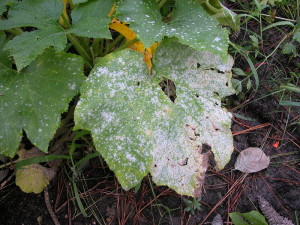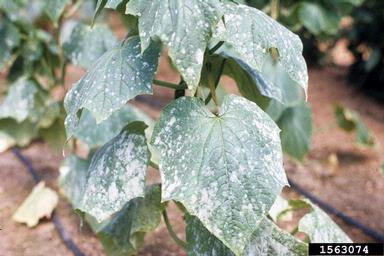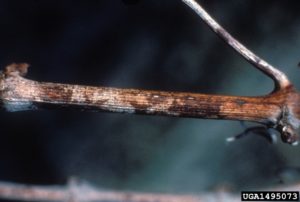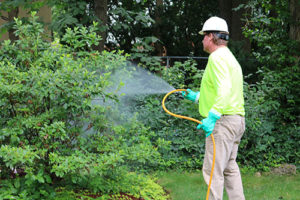
It’s that time of year again! Powdery Mildew is starting to cover leaves and spread throughout landscapes. Powdery Mildew is the name used to describe a group of fungal diseases caused by fungi in the order Erysiphales. Characterized by patches of white to grayish, talcum-powder-like growth, Powdery Mildew is usually easy to spot. And although Powdery Mildew won’t typically kill a tree by itself, it is an eyesore and can lead to health problems down the road. This fungus can starve your tree of nutrients and increase the stress put on the plant making the tree/shrub susceptible to deadly diseases and insects. If you have trees and shrubs that are susceptible to Powdery Mildew our Arborists warn to be on the lookout for early signs of this fungus.
Trees & Shrubs Susceptible To Powdery Mildew:
Powdery Mildew infects a wide range of plants and trees. Susceptible species include Lilacs, Peonies, Dogwoods, Roses, Azaleas, Crape Myrtles, Oaks, Rhododendrons, Hydrangeas, and Euonymus. Trees and shrubs that are in fully shaded areas and lack good airflow are also susceptible.
Signs and Symptoms Of Powdery Mildew:
- spots or patches of white to grayish, talcum-powder-like growth. Typically seen on the upper side of leaves but can also show on the bottom side, young stems, flowers, and young fruit.
- yellowing leaves
- leaf wilt
- branch dieback
- distorted leaves (advanced symptom)
- premature leaf drop (advanced symptom)
- blemishes on fruit (advanced symptom)
- buds that won’t open (advanced symptom)


How Does It Hurt My Tree?
Powdery Mildew coats the trees leaves blocking the process of photosynthesis which turns light into food for trees and shrubs. Every year trees and shrubs rely on their food reserves to push out new leaf growth. These newly produced leaves must then replenish the food supply through photosynthesis. When this process is interrupted by powdery mildew the food reserves aren’t replenished and the tree/shrub’s growth will be stunted which can affect overall health. The stress caused by Powdery Mildew will also make the tree more susceptible to other diseases and insect infestations that could be deadly.
Powdery Mildew Treatment:

Powdery Mildew can be treated by a Certified Arborist with fungicide treatments. If you think your trees or shrubs are showing signs of Powdery Mildew schedule an appointment with one of our Certified Arborists to get a diagnosis and begin treatment. If your trees and shrubs are NOT showing signs of Powdery Mildew yet, that’s great! However, it’s important to take simple steps to prevent the fungus from developing in the first place.
Need Help With Powdery Mildew?
Or Call 703-573-3029
Powdery Mildew Prevention:
Prevent Powdery Mildew by following the simple tips we’ve listed below.
- Plant susceptible trees and shrubs in full sun.
- Prune trees and shrubs regularly to improve airflow.
- Water susceptible plants from below. Use drip lines or hoses instead of sprinklers that wet the plant’s leaves.
- Rake all leaves and remove them from the property so fungus and diseases don’t overwinter in the leave piles and re-infect your trees/shrubs next spring.
- When purchasing a new tree or plant make sure they are Powdery Mildew resistant. Resistant species include Cherokee Brave Dogwoods, Catawba Crape Myrtle, Cherokee Crape Myrtle, Hope Crape Myrtle, Simplicity Rose, Meidiland Rose, Rhododendron Yakushimanum, Rhododendron Macrophyllum, Rhododendron Nova Zembla, and Rhododendron Palestrina.
If your tree is showing signs or symptoms of Powdery Mildew or you would like to work towards preventing this fungus and other plant pests we can help. Our Certified Arborists can diagnose your tree and shrub issues and give you either a treatment plan or prevention plan (Canopy Protection Program) depending on your needs. To schedule an appointment, give us a call at 703-573-3029 or book through our online appointment system.


